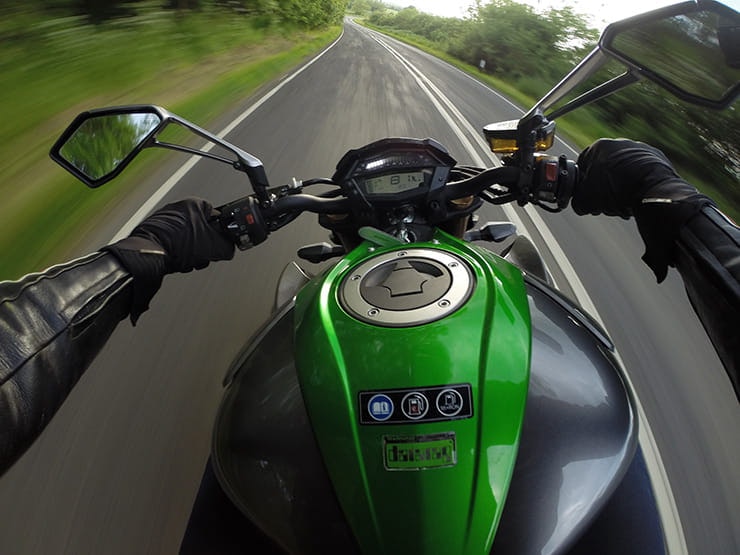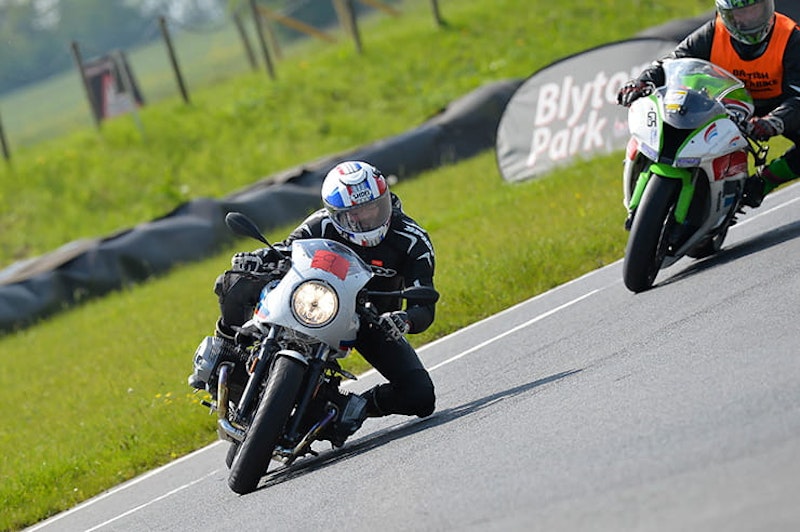On a naked bike like this Z1000 (above), your arms are naturally in a decent position for steering. To turn faster, you’ll have to crouch forward so your forearms are parallel with the road.Photo by IMG photography
Your expert: Crispin d’Albertanson is a Nurburgring coach, senior IAM observer and ex-endurance racer who now works with the well-respected Hopp Rider Training. You can book a course on road or track at www.hoppridertraining.co.uk or 07881 878989
The BMW R NineT Racer is the perfect example of a bike that tempts you into riding with straight arms. To steer effectively, you need to be in a racing crouch.
So what’s counter-steering all about?
For the time being forget counter-steering. Lots of people have heard of it these days, but the physics is complicated and people get confused with terminology. Instead, think positive steering - push left to go left, push right to go right.
I think I might already be doing this...
Everybody counter-steers in their subconscious, otherwise bikes would not go round corners at anything more than 15mph, but if we can get that understanding into our conscious, we can improve it. I encourage people to actively talk their way round corners, to say to themselves ‘I want to go left, I’m going to push left’.
Really, you want me to talk to myself?
It’s surprising how often people don’t think of the sequence of what they’re doing - when you ask someone like that how they are going round a corner, you just get a blank face. Almost all of our first time students are in that category.
So then what? I just give the bar a good push?
The best way to learn it is experimental - try pushing left, see what happens. I can explain all the physics but it’s much more effective if people actually experience it working.
So what else should I be doing?
Relaxation on the machine is important. If you’ve got stiff, straight arms, you’re not going to be able to steer because you have no way of pushing the inside bar with any force. You need to relax your elbows, drop into a comfortable crouch and keep your hands loose.
I ride an R1 and spend most of my time with straight arms - I'm guessing this is bad?
Yes. Most adventure bikes and some nakeds put you in an ergonomic riding position, with your arms slightly bent. On a sportsbike you actively have to adopt the crouch and a lot of people think ‘I feel a bit of a prat doing this’ and so ride with straight arms. Also, if your neck is stiff you’re not going to be able to look through corners easily - or indeed look anywhere apart from straight ahead. You can’t scan ahead like that. And a stiff neck usually translates as tension through the entire upper body.
Just about to tip in, now’s the time to consciously think about pushing that right bar to go right.
How can I tell if I'm relaxed?
One symptom of tension is fatigue - if you arrive home after an hour’s ride and you’re absolutely exhausted, then it’s unlikely you have been riding relaxed. And the more fatigued you are, the less you’re able to concentrate, and the more tense you become.
OK, I’m convinced. So how long should I allow to get this right?
Like learning anything new, changing your riding position and adopting positive steering takes time - if you alter someone’s default position, which might be the very thing that’s holding them back, they feel awkward. In order to perfect a new technique, athletes work on the basis that they need to practice it over 2500 times before they become comfortable with it - it takes 2500 repetitions to change an ingrained practice. Therefore, if you try something on a course 50 or 100 times, it’s still bound to feel awkward when you leave. You have to believe it’s worth practicing when you’re riding alone.
Any other tips?
Practice at the right time. Imagine you’re following your mates on a Sunday afternoon, watching the guy’s numberplate in front not the road, when you hurtle into a left hand bend which turns out to be a lot tighter than you thought. That is not the time to start learning about counter-steering. You need lots of practice at gentle speeds on quiet roads.

